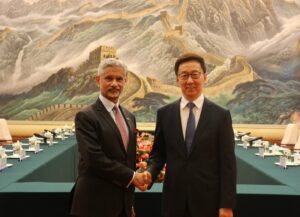GS2 – International Relations

Context
The Indian External Affairs Minister’s recent high-level dialogue with China—the first since the Galwan clash—indicates a gradual movement towards a structured and calibrated normalisation of ties. This approach seeks to restart the long-stalled “Dragon-Elephant” engagement through measured diplomatic, military, and economic initiatives.
Importance of Stability in Bilateral Relations
Economic Benefits
- Trade and Investment: A stable relationship underpins the $120 billion trade partnership and enables targeted Chinese investments in non-strategic areas.
- Supply Chain Assurance: Normalisation ensures India’s access to essential inputs such as APIs, semiconductors, and rare earths vital for industrial resilience.
- Diversification Strategy: Calm relations support efforts like the “China+1” strategy and Quad-led tech collaborations, encouraging supply chain shifts away from China.
Strategic Autonomy and Leverage
- Border Stability Advantage: Reduced tensions along the LAC help India focus on broader military strategy by easing two-front deployment challenges.
- Balanced Diplomacy: Normalised ties allow India to simultaneously deepen Quad engagements and maintain constructive communication with China.
- Multilateral Forums: Stability facilitates India’s constructive participation in BRICS and SCO while preserving its independent policy space.
Cooperation on Connectivity, Water, and Climate
- Border Trade Revival: Stability enabled the reopening of the Nathu La route, boosting economic recovery in border areas.
- Hydrological Engagement: Resumption of data-sharing on Brahmaputra floods reflects renewed trust in water cooperation.
- Clean-Tech Collaboration: Joint initiatives in clean technologies support India’s transition to net-zero emissions and secure rare earth access.
Recent Steps Towards Normalisation
- 75-Year Milestone (2025): The two countries marked 75 years of diplomatic relations with renewed intent to improve engagement.
- LAC Disengagement: Full withdrawal from Depsang and Demchok was achieved by the end of 2024.
- Border Trade: Nathu La was officially reopened to strengthen economic ties in frontier regions.
- SR Dialogue Revived: The 2024 meeting of Special Representatives rekindled official border negotiations.
- BRICS Leadership Interaction: A Modi-Xi meeting at the 2023 Kazan BRICS Summit was the first structured top-level engagement since 2019.
- Hydro Cooperation: China resumed sharing flood data on Brahmaputra and Sutlej in 2025.
- Pilgrimage Diplomacy: The Kailash Mansarovar Yatra resumed in April 2025, acting as a people-centric confidence-building measure.
Persistent Challenges
- Border Disputes: The Galwan incident and subsequent incremental advances reveal the limits of disengagement frameworks.
- Deficit of Trust: China’s non-transparent conduct and delayed responses erode mutual confidence.
- Cartographic Offensives: Renaming of areas in Arunachal and aggressive mapping tactics exacerbate perception wars.
- Trade Asymmetry: A trade deficit exceeding $100 billion and Chinese curbs on rare earth exports highlight underlying imbalances.
- Pakistan Factor: China’s deep strategic ties with Pakistan—covering defence, nuclear, and economic domains—complicate India’s core security interests.
- Regional Competition: Beijing’s expanding footprint in Nepal, Myanmar, and Sri Lanka limits India’s influence in South Asia.
- Terrorism Divergence: China’s refusal to categorically address Pakistan-based terror networks impedes SCO counter-terrorism efforts.




